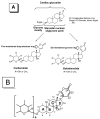Chemistry and the Potential Antiviral, Anticancer, and Anti-Inflammatory Activities of Cardiotonic Steroids Derived from Toads
- PMID: 36235123
- PMCID: PMC9571018
- DOI: 10.3390/molecules27196586
Chemistry and the Potential Antiviral, Anticancer, and Anti-Inflammatory Activities of Cardiotonic Steroids Derived from Toads
Abstract
Cardiotonic steroids (CTS) were first documented by ancient Egyptians more than 3000 years ago. Cardiotonic steroids are a group of steroid hormones that circulate in the blood of amphibians and toads and can also be extracted from natural products such as plants, herbs, and marines. It is well known that cardiotonic steroids reveal effects against congestive heart failure and atrial fibrillation; therefore, the term "cardiotonic" has been coined. Cardiotonic steroids are divided into two distinct groups: cardenolides (plant-derived) and bufadienolides (mainly of animal origin). Cardenolides have an unsaturated five-membered lactone ring attached to the steroid nucleus at position 17; bufadienolides have a doubly unsaturated six-membered lactone ring. Cancer is a leading cause of mortality in humans all over the world. In 2040, the global cancer load is expected to be 28.4 million cases, which would be a 47% increase from 2020. Moreover, viruses and inflammations also have a very nebative impact on human health and lead to mortality. In the current review, we focus on the chemistry, antiviral and anti-cancer activities of cardiotonic steroids from the naturally derived (toads) venom to combat these chronic devastating health problems. The databases of different research engines (Google Scholar, PubMed, Science Direct, and Sci-Finder) were screened using different combinations of the following terms: "cardiotonic steroids", "anti-inflammatory", "antiviral", "anticancer", "toad venom", "bufadienolides", and "poison chemical composition". Various cardiotonic steroids were isolated from diverse toad species and exhibited superior anti-inflammatory, anticancer, and antiviral activities in in vivo and in vitro models such as marinobufagenin, gammabufotalin, resibufogenin, and bufalin. These steroids are especially difficult to identify. However, several compounds and their bioactivities were identified by using different molecular and biotechnological techniques. Biotechnology is a new tool to fully or partially generate upscaled quantities of natural products, which are otherwise only available at trace amounts in organisms.
Keywords: anti-inflammatory; anticancer; antiviral; bufadienolides; bufalin; bufotalin; cardiotonic steroids.
Conflict of interest statement
The authors declare no conflict of interest.
Figures





Similar articles
-
Conformational states of the pig kidney Na+/K+-ATPase differently affect bufadienolides and cardenolides: A directed structure-activity and structure-kinetics study.Biochem Pharmacol. 2020 Jan;171:113679. doi: 10.1016/j.bcp.2019.113679. Epub 2019 Oct 24. Biochem Pharmacol. 2020. PMID: 31669257
-
Cytochrome P450 Mining for Bufadienolide Diversification.ACS Chem Biol. 2024 May 17;19(5):1169-1179. doi: 10.1021/acschembio.4c00089. Epub 2024 Apr 16. ACS Chem Biol. 2024. PMID: 38624108
-
Novel stereoselective bufadienolides reveal new insights into the requirements for Na(+), K(+)-ATPase inhibition by cardiotonic steroids.Sci Rep. 2016 Jul 5;6:29155. doi: 10.1038/srep29155. Sci Rep. 2016. PMID: 27377465 Free PMC article.
-
Cardioactive steroid poisoning: a comparison of plant- and animal-derived compounds.J Med Toxicol. 2006 Dec;2(4):152-5. doi: 10.1007/BF03161183. J Med Toxicol. 2006. PMID: 18072135 Free PMC article. Review.
-
Bufadienolides from amphibians: A promising source of anticancer prototypes for radical innovation, apoptosis triggering and Na+/K+-ATPase inhibition.Toxicon. 2017 Mar 1;127:63-76. doi: 10.1016/j.toxicon.2017.01.004. Epub 2017 Jan 7. Toxicon. 2017. PMID: 28069354 Review.
Cited by
-
Evaluation of Anti-Inflammatory Activity of the New Cardiotonic Steroid γ-Benzylidene Digoxin 8 (BD-8) in Mice.Cells. 2024 Sep 18;13(18):1568. doi: 10.3390/cells13181568. Cells. 2024. PMID: 39329752 Free PMC article.
-
Molecular Aspects in the Development of Type 2 Diabetes and Possible Preventive and Complementary Therapies.Int J Mol Sci. 2024 Aug 22;25(16):9113. doi: 10.3390/ijms25169113. Int J Mol Sci. 2024. PMID: 39201799 Free PMC article. Review.
-
Animal-derived natural products for hepatocellular carcinoma therapy: current evidence and future perspectives.Front Pharmacol. 2024 May 9;15:1399882. doi: 10.3389/fphar.2024.1399882. eCollection 2024. Front Pharmacol. 2024. PMID: 38803433 Free PMC article. Review.
-
A systematic pan-cancer analysis identifies LDHA as a novel predictor for immunological, prognostic, and immunotherapy resistance.Aging (Albany NY). 2024 May 3;16(9):8000-8018. doi: 10.18632/aging.205800. Epub 2024 May 3. Aging (Albany NY). 2024. PMID: 38709280 Free PMC article.
-
Resibufogenin: An Emerging Therapeutic Compound with Multifaceted Pharmacological Effects - A Comprehensive Review.Med Sci Monit. 2024 Feb 19;30:e942783. doi: 10.12659/MSM.942783. Med Sci Monit. 2024. PMID: 38369741 Free PMC article. Review.
References
-
- El-Bakry A.A., Hammad I.A., Galal T.M., Ghazi S.M., Rafat F.A. Polymorphism in Calotropis procera: Variation of metabolites in populations from different phytogeographical regions of Egypt. Rend. Lincei. 2014;25:461–469. doi: 10.1007/s12210-014-0315-z. - DOI
Publication types
MeSH terms
Substances
Grants and funding
LinkOut - more resources
Full Text Sources
Research Materials


